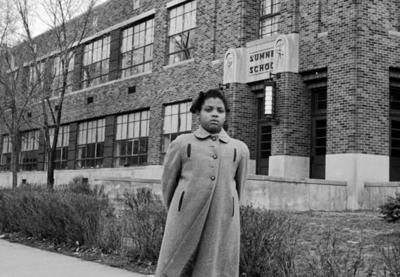Linda Carol Brown Thompson passed away on March 25, 2018. Those who study civil rights history will instantly recognize her as the girl at the center of Brown v. Board of Education of Topeka, the 1954 Supreme Court decision that declared unconstitutional any state law that separated school children by race. The decision effectively reversed Plessy v. Ferguson, the 1896 ruling that had introduced "separate but equal" into the legal lexicon of the United States and solidified the perceived legitimacy of racial segregation in public spaces for decades.
Much has been written about the court's decision in Brown v. Board, about the legal significance of condemning de jure segregation, and about the swiftness with which white leaders and families began finding ways—legal and extralegal—to maintain exclusively white schools.
Thompson's passing offers educators an opportunity to pause and think about her role in the case and to reflect on what life was like for African Americans at this pivotal (and still highly contested) moment in our country's continuing and uneven struggle toward racial justice.
Thompson was 9 when the lawsuit was introduced by her father Oliver L. Brown, one of 13 parents (representing 20 children) who sought educational equality for their children. (The Brown suit combined five separate cases, all brought by NAACP attorneys.)
Think about your students or children in your life who are 9. It's an age at which kids start to find real independence but still see the world through the eyes of a child. They're becoming self-aware but still depend on adults more than friends for emotional guidance and support.
Thompson always maintained a reflective and pragmatic tone when she discussed the case as an adult; indeed, what we know about her 9-year-old self indicates she was likely also a reflective and pragmatic child. But her courage and the courage of her family cannot be overestimated. The decision to make her the face of such a monumental case was not only an act of parental love motivated by the desire to provide her with a better education. It was also a decision to put aside personal comfort and safety in the pursuit of justice for African Americans everywhere.
Even at the tender age of 9, the girl who was then Linda Brown was aware of the case's significance and of the attention—positive and negative—that the decision would bring. After the decision, she attended integrated schools (and earned top grades) for the remainder of her elementary, middle and high school years.
It can't have been easy. To understand the significance of her role as the face of this case, we must also think about the reality that "separate but equal" had created for black families in 1954.
Seventeen U.S. states mandated segregation. These laws affected about 9 million white children and 2.3 million black children in public schools. Four other states allowed segregation but did not require it. The remaining 27 (Alaska and Hawaii not yet states) either had laws prohibiting segregation or had no laws regarding segregation. In those states, segregation still occurred based not on laws but on social and economic factors.
The scene varied from state to state, but the patterns were clear in the South:
- White hospital patients could be tended only by white nurses; black patients, only by black nurses.
- Textbooks used by white students were kept separate from those used by black students; interchanging them was forbidden.
- Even in prisons, white prisoners could not be shackled with black inmates on chain gangs.
James T. Patterson, in Brown v. Board of Education: A Civil Rights Milestone and its Troubled Legacy, paints this picture of 1950s Kansas, a border state balancing elements of South and North:
Topeka did not impose a color line in the waiting rooms of its bus and train stations or on its buses. Yet five of the seven movie houses barred black people, a sixth was for blacks, and the seventh admitted blacks to its balcony—"N----r Heaven," it was called. The park swimming pool was closed to blacks except for one day in the year. A restaurant regularly patronized by the white lawyer who was to handle the Brown case on behalf of Topeka featured a sign, "Colored and Mexicans served in sacks only."
In 1954, collective shock over the brutal murder of Emmett Till had not yet galvanized the nation; Rosa Parks hadn't yet refused to give up her seat on a Montgomery bus; and Dr. Martin Luther King Jr.'s "I Have a Dream" speech was still years away.
It was in this context that Linda Brown Thompson sought the opportunity to attend a local school rather than walking miles to the black school (walks during which she remembers getting so cold she turned around and came home crying).
As we remember her, let us pause to truly recognize her bravery and the bravery of the other families at the heart of the case.
In the words of Sherrilyn Ifill, president of the NAACP Legal Defense and Educational Fund, "The life of every American has been touched by Linda Brown."
van der Valk is the deputy director for Teaching Tolerance.
